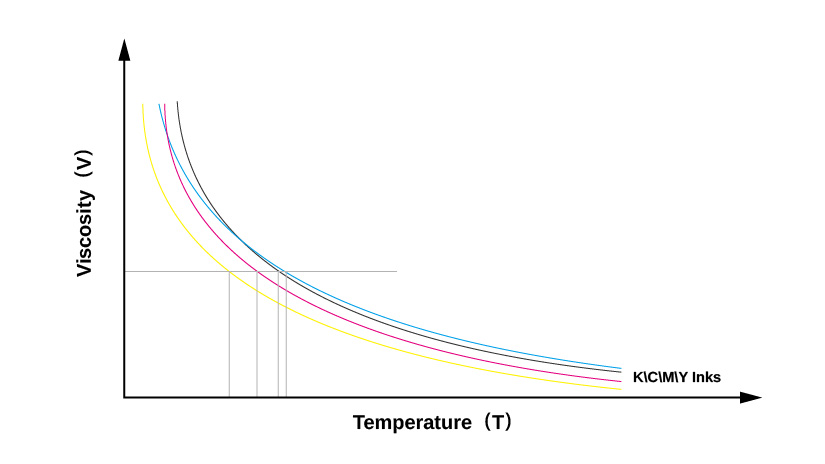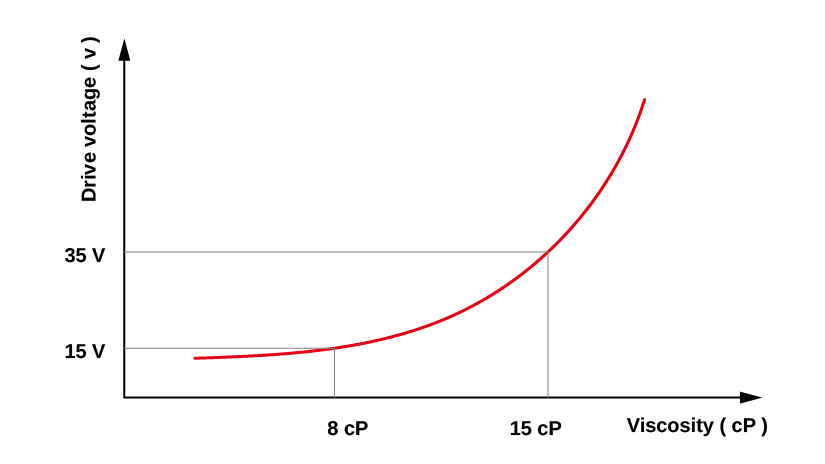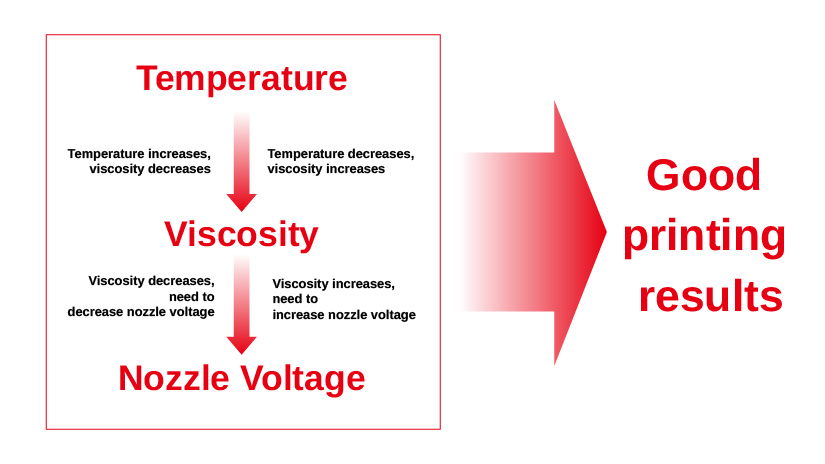In the operation of digital printers, there exists a close dynamic correlation between ink viscosity, temperature, and nozzle voltage. Their coordinated state directly impacts printing quality (such as droplet size, landing precision, color uniformity) and equipment stability. The following provides a systematic explanation from three perspectives: core concepts, interaction mechanisms, and practical implications with regulatory logic.
I. Core Concepts and Individual Functions
1. Ink Viscosity
Viscosity is a physical property that measures the internal friction within ink, directly determining how easily the ink flows:
- Excessively high viscosity: The ink has poor fluidity and is prone to clogging the nozzle, preventing ink droplets from being ejected smoothly and leading to issues like line breaks and ink shortages.
- Excessively low viscosity: The ink is overly thin and tends to spread excessively after ejection, which may result in blurring, color bleeding, or abnormal merging of ink droplets due to insufficient surface tension.
2. Temperature
Temperature is a key factor in regulating ink viscosity, with its effect on viscosity following a clear pattern:
- A rise in temperature → Intensified movement of ink molecules → Weakened intermolecular forces → Reduced viscosity (enhanced fluidity).
- A drop in temperature → Slowed molecular movement → Strengthened intermolecular forces → Increased viscosity (diminished fluidity).
Different types of inks vary in their sensitivity to temperature. For instance, water-based inks are more significantly affected by temperature than solvent-based and UV-curable inks.
3. Nozzle Voltage
Nozzle voltage (driving voltage) determines the ink ejection state by controlling the operational intensity of core components:
- For piezoelectric crystal nozzles: Increased voltage → Greater deformation of the crystal → Faster speed and larger volume of ejected ink droplets; Decreased voltage → Less deformation → Slower speed and smaller volume of ink droplets.
- For thermal bubble nozzles: Increased voltage → Stronger pressure generated by thermal bubbles → Higher kinetic energy of ink droplets; Decreased voltage → Weaker pressure → Insufficient kinetic energy of ink droplets, which may cause deviations in landing positions.

II. Interaction Mechanism: Dynamic Balance Between Power and Resistance
1. Direct Correlation Between Temperature and Viscosity
Temperature is the core driving factor behind changes in viscosity, and there is a significant negative correlation between the two:
- When the ambient temperature rises (e.g., from 25℃ to 35℃), the viscosity of Epson weak solvent ink may decrease from 4.2cP to 3cP; when solvent-based ink is cooled from 25℃ to 15℃, its viscosity may increase from 8cP to 10cP.
- This correlation is universal. The order of sensitivity to temperature among different ink types (UV ink, water-based ink, solvent-based ink) is: UV ink > water-based ink > solvent-based ink, though the trend of change remains consistent.

2. Adaptation Logic Between Viscosity and Nozzle Voltage
Nozzle voltage provides the “power” for ink ejection, while viscosity represents the “resistance” to ink flow. They need to be dynamically matched:
- When viscosity increases: The flow resistance of the ink rises, so the nozzle voltage must be increased to enhance the driving force, ensuring that ink droplets can overcome the resistance and be ejected smoothly.
- When viscosity decreases: The ink resistance lessens, so the nozzle voltage should be reduced to weaken the driving force, preventing uncontrolled diffusion of ink droplets due to excessive power.

III. Practical Implications and Regulatory Logic
1. Chain Reaction: Temperature → Viscosity → Voltage
The chain effect of these three factors forms a clear regulatory pathway:
- High-temperature environment (low viscosity):
Chain reaction: Temperature ↑ → Viscosity ↓ → Excessively high ink fluidity (low resistance).
Voltage requirement: Maintaining the original voltage would easily cause ink droplets to be too large and fast, resulting in “blurring”, “ink splattering”, or nozzle leakage. Thus, the voltage needs to be reduced (e.g., in the standard state of 25℃, 15cP, 30V, when the temperature rises to 35℃ and the viscosity drops to 10cP, the voltage should be adjusted to 24-26V).
- Low-temperature environment (high viscosity):
Chain reaction: Temperature ↓ → Viscosity ↑ → Poor ink fluidity (high resistance).
Voltage requirement: Keeping the original voltage would lead to insufficient driving force, causing ink droplets to be ejected weakly and resulting in line breaks or clogging. Therefore, the voltage needs to be increased (e.g., in the standard state of 25℃, 15cP, 30V, when the temperature drops to 15℃ and the viscosity rises to 20cP, the voltage should be adjusted to 34-36V).

2. Dual Regulation Strategy Under Extreme Temperatures
When the temperature exceeds the conventional range (ultra-high temperature > 40℃, ultra-low temperature < 5℃), simply adjusting the voltage is insufficient, and temperature control equipment must be used in conjunction:
- Ultra-high temperature environment: The viscosity may drop below 8cP. Even with reduced voltage, “stringing” (inability to form complete ink droplets) may occur. It is necessary to activate the cooling device to stabilize the ink temperature, followed by appropriate voltage adjustment.
- Ultra-low temperature environment: The viscosity may rise above 30cP. Even with increased voltage, nozzle components (such as piezoelectric crystals) may have insufficient driving force due to slow response at low temperatures. It is necessary to reduce the viscosity using the ink circuit heating device and then make appropriate voltage adjustments.
Summary
The relationship between ink viscosity, temperature, and nozzle voltage can be summarized as: Temperature determines the viscosity baseline, viscosity determines the voltage requirement, and voltage ultimately regulates the state of ink droplets. The core logic is:
- A rise in temperature → A decrease in viscosity → Voltage needs to be turned down (to avoid excessive driving force);
- A drop in temperature → An increase in viscosity → Voltage needs to be turned up (to compensate for increased resistance).
In practical operation, the focus should be on the core goal of “maintaining the stability of ink droplet morphology”. The voltage should be dynamically adjusted based on real-time changes in temperature and viscosity, and temperature control equipment should be used when necessary to ensure printing quality and equipment stability.